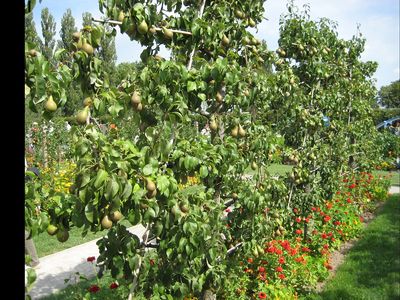Espalier: Difference between revisions
Jump to navigation
Jump to search
m (changed size of pic) |
No edit summary |
||
| Line 1: | Line 1: | ||
{{Category=Growing plants}} | |||
=Background= | =Background= | ||
[[Image:espalier.jpg|400px|thumb|Espalier pears at an exhibit in Germany, July 2009; bamboo used for support.]] | [[Image:espalier.jpg|400px|thumb|Espalier pears at an exhibit in Germany, July 2009; bamboo used for support.]] | ||
| Line 8: | Line 9: | ||
* http://en.wikipedia.org/wiki/Espalier | * http://en.wikipedia.org/wiki/Espalier | ||
* article: [http://www.woodbridgefruittrees.com.au/resources/Articles/Espaliering%20Made%20Even%20Easier%20(KNNN).pdf Espaliering Made Even Easier - the KNNN System of Growing Apples] | * article: [http://www.woodbridgefruittrees.com.au/resources/Articles/Espaliering%20Made%20Even%20Easier%20(KNNN).pdf Espaliering Made Even Easier - the KNNN System of Growing Apples] | ||
Revision as of 18:51, 7 February 2011
Main > Food and Agriculture > Growing plants
Background
Espalier is a centuries-old horticultural technique to grow fruit trees in a "flat" way, and often against a wall. The main advantage is that space requirements are minimized. This technique is more labor intensive than regular fruit growing and requires more knowledge and care. However, there are also advantages, such as easier fruit picking and simpler netting to protect fruits from birds and other pests. The espalier trees are also highly ornamental. Suitable are apples, pears, apricots, peaches and many others. These trees may be grown in high latitudes against a sunny wall, which will serve as a heat buffer.
